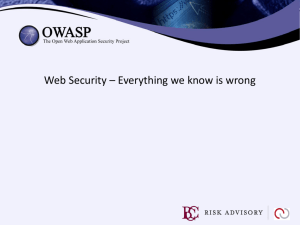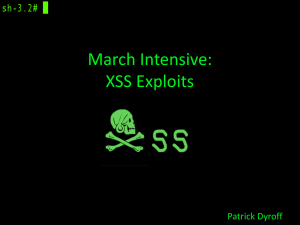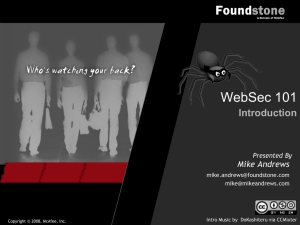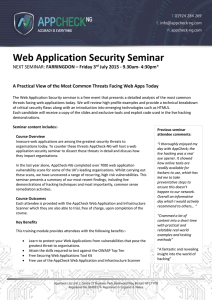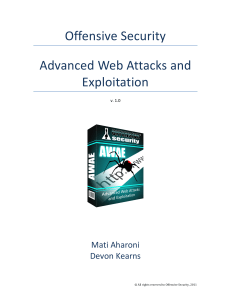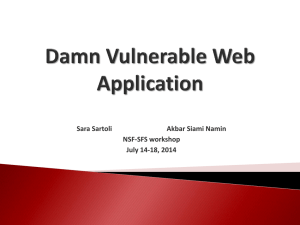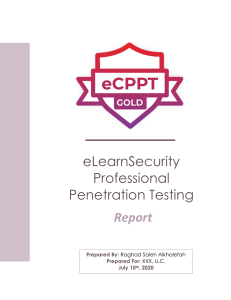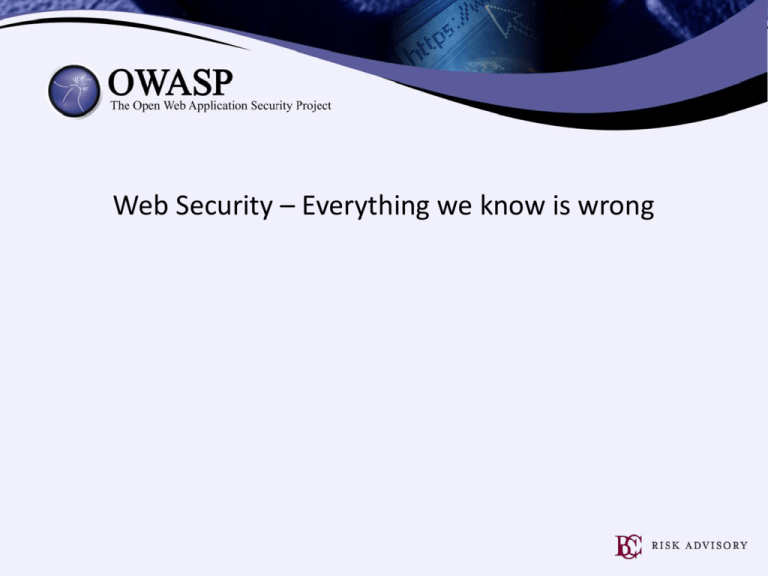
Web Security – Everything we know is wrong
Eoin Keary
• CTO BCCRISKADVISORY.COM
• OWASP GLOBAL BOARD MEMBER
• OWASP Reboot & Code Review Project Lead
HACKED
3
Last Week (11th November):
“Loyaltybuild” BREACH
1,100,000
30
$$$
Globally,
2012 Cyber Crime
every
second, 18 • US $20.7 billion in direct losses
• Global $110 billion in direct losses
adults
• Global $338 billion + downtime
become
victims of
“The loss of industrial information and intellectual
cybercrime property through cyber espionage constitutes the
- Symantec greatest transfer of wealth in history” - Keith
“One
hundred
BILLION
dollars” Dr Evil
Alexander
Almost 1 trillion USD was spent in
2012 protecting against cybercrime
Eoin, I didn’t click it – My
Grandma
“556 million adults across the world have first-hand experience of
cybercrime -- more than the entire population of the European
Union.”
Its (not) the $$$$
Information
security spend
Security incidents
(business impact)
……we are approaching this problem
[software <in>Security] completely wrong and
have been for years…..
Asymmetric Arms Race
A traditional end of cycle / Annual pentest only
gives minimal security…..
There are too many variables and too little time
to ensure “real security”.
Two weeks of
ethical hacking
Business
Logic Flaws
Security
Errors
Code
Flaws
Ten man-years of
development
Make this more difficult: Lets change the application code once a month.
"Risk comes from not knowing what you're
doing." - Warren Buffet
Time Limited:
Consultant “tune tools”
Use multiple tools – verify issues
Customize Attack Vectors to technology stack
Achieve 80-90 application functionality coverage
A fool with a tool, is still a fool”…..?
Experience
As good as the bad guys?
Code may be pushed frequently:
Erosion of Penetration test?
Window of Exploitation?
Tools with Tunnel Vision:
Problem has moved (back) to the client.
Some “Client Side” vulnerabilities can’t be tested via HTTP parameter testing.
AJAX
Flex/Flash/Air
Native Mobile Web Apps – Data Storage, leakage, malware.
DOM XSS – Sinks & Sources in client script -> no HTTP required
Scanning in not enough anymore.
We need DOM security assessment.
- Javascript parsing/ Taint analysis/ String analysis
http://code.google.com/p/domxsswiki/
“We need an Onion”
SDL
Design review
Threat Modeling
Code review/SAST
Negative use/abuse cases/Fuzzing/DAST
Live/
Ongoing
Continuous/Frequent monitoring / Testing
Manual Validation
Vulnerability management & Priority
Dependency Management ….
“Robots are good at detecting known unknowns”
“Humans are good at detecting unknown unknowns”
You are what you eat
Cheeseburger Security
We know they are bad for us, but who cares, right?
If we eat too many we may get a heart attack? …sound familiar
We also write [in]secure code until we get hacked
The Cheeseburger approach: “Cheeseburger risk’ is the kind of risk you
deliberately take even knowing the consequences, until those consequences
actually come to pass.”
Software food chain
COTS
(Commercial off
the shelf
Application
Code
Outsourced
development
SubContractors
Third Party
API’s
Bespoke
outsourced
development
Third Party
Components
& Systems
Bespoke Internal
development
More
Degrees of trust
Less
You may not let some of the people who have developed your code into your offices!!
19
2012- Study of 31 popular open source libraries.
- 19.8 million (26%) of the library downloads
have known vulnerabilities.
- Today's applications may use up to 30 or more
libraries - 80% of the codebase
Spring - application development framework :
downloaded 18 million times by over 43,000
organizations in the last year. – Vulnerability:
Information leakage CVE-2011-2730
http://support.springsource.com/security/cve-2011-2730
In Apache CXF– application framework: 4.2
million downloads.- Vulnerability: high risk CVE2010-2076 & CVE 2012-0803
http://svn.apache.org/repos/asf/cxf/trunk/security/CVE-2010-2076.pdf
http://cxf.apache.org/cve-2012-0803.html
Do we test for "dependency“ issues?
NO
Does your patch management policy cover
application dependencies?
Check out: https://github.com/jeremylong/DependencyCheck
Bite off more than we chew
“We can’t improve what we can’t measure”
How can we manage vulnerabilities on a large
scale….
Say 300 web applications:
300 Annual Penetration tests
10’s of different penetration testers?
300 reports
How do we consume this Data?
Enterprise Security Intelligence:
Consolidation of vulnerability data.
Continuous active monitoring
Vulnerability Management solutions
Delta Analysis is Key: Initial testing is most work. Subsequent
testing is easier we focus on delta/change.
Metrics: We can measure what problems we have
Measure: We cant improve what we cant measure
Priority: If we can measure we can prioritise
Delta: If we can measure we can detect change
Apply: We can apply our (limited) budget on the right things
Improve: We can improve where it matters……
Value: Demonstrate value to our business
Answer the question: “Are we secure?” <- a little better
Information flooding
(Melting a developers brain, White noise and
“compliance”)
Doing things right != Doing the right things.
“Not all bugs/vulnerabilities are equal”
(is HttpOnly important if there is no XSS?)
Context is important!
Contextualize Risk
(is XSS /SQLi always High Risk?)
Do developers need to fix everything?
- Limited time
- Finite Resources
- Task Priority
- Pass internal audit?
Dick Tracy
White Noise
Compliance
There’s Compliance:
EU directive:
http://register.consilium.europa.eu/pdf/en/12/st05/st05853.
en12.pdf
Article 23,24 & 79, - Administrative sanctions
“The supervisory authority shall impose a fine up to 250 000
EUR, or in case of an enterprise up to 0.5 % of its annual
worldwide turnover, to anyone who, intentionally or
negligently does not protect personal data”
…and there’s Compliance
Clear and Present Danger!!
Update:
Kinder eggs are now legal in the USA.
You’re Welcome!!
Problem
Explain issues in “Developer speak” (AKA English)
Is Cross-Site Scripting the same as SQL injection?
Both are injection attacks -> code and data
being confused by system.
LDAP Injection, Command Injection, Log Injection, XSS, SQLI etc etc
XSS causes the browser to execute user
supplied input as code. The input breaks out of
the [data context] and becomes [execution
context].
SQLI causes the database or source code
calling the database to confuse [data context]
and ANSI SQL [ execution context].
Command injection mixes up [data context]
and the [execution context].
To Conclude….
We need to understand what we are protecting against.
We need to understand that a pentest alone is a loosing battle.
You can only improve what you can measure
Not all bugs are created equal.
Bugs are Bugs. Explain security issues to developers in “Dev speak”
Thanks for Listening
eoin@bccriskadvisory.com
Eoin.Keary@owasp.org
@eoinkeary
www.bccriskadvisory.com
© BCC Risk Advisory Ltd 2013 ..
All rights reserved.

